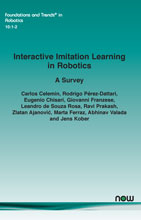Interactive Imitation Learning in Robotics: A Survey
By Carlos Celemin, Delft University of Technology, Netherlands, c.e.celeminpaez@tudelft.nl | Rodrigo Pérez-Dattari, Delft University of Technology, Netherlands, r.j.perezdattari@tudelft.nl | Eugenio Chisari, University of Freiburg, Germany, chisari@cs.uni-freiburg.de | Giovanni Franzese, Delft University of Technology, Netherlands, g.franzese@tudelft.nl | Leandro de Souza Rosa, Delft University of Technology, Netherlands, l.desouzarosa@tudelft.nl | Ravi Prakash, Delft University of Technology, Netherlands, r.prakash-1@tudelft.nl | Zlatan Ajanović, Delft University of Technology, Netherlands, z.ajanovic@tudelft.nl | Marta Ferraz, Delft University of Technology, Netherlands, m.ferraz@tudelft.nl | Abhinav Valada, University of Freiburg, Germany, valada@cs.uni-freiburg.de | Jens Kober, Delft University of Technology, Netherlands, j.kober@tudelft.nl
Abstract
Interactive Imitation Learning (IIL) is a branch of Imitation Learning (IL) where human feedback is provided intermittently during robot execution allowing an online improvement of the robot’s behavior.
In recent years, IIL has increasingly started to carve out its own space as a promising data-driven alternative for solving complex robotic tasks. The advantages of IIL are twofold, 1) it is data-efficient, as the human feedback guides the robot directly towards an improved behavior (in contrast with Reinforcement Learning (RL), where behaviors must be discovered by trial and error), and 2) it is robust, as the distribution mismatch between the teacher and learner trajectories is minimized by providing feedback directly over the learner’s trajectories (as opposed to offline IL methods such as Behavioral Cloning).
Nevertheless, despite the opportunities that IIL presents, its terminology, structure, and applicability are not clear nor unified in the literature, slowing down its development and, therefore, the research of innovative formulations and discoveries.
In this work, we attempt to facilitate research in IIL and lower entry barriers for new practitioners by providing a survey of the field that unifies and structures it. In addition, we aim to raise awareness of its potential, what has been accomplished and what are still open research questions.
We organize the most relevant works in IIL in terms of human-robot interaction (i.e., types of feedback), interfaces (i.e., means of providing feedback), learning (i.e., models learned from feedback and function approximators), user experience (i.e., human perception about the learning process), applications, and benchmarks. Furthermore, we analyze similarities and differences between IIL and RL, providing a discussion on how the concepts offline, online, off-policy and on-policy learning should be transferred to IIL from the RL literature.
We particularly focus on robotic applications in the real world and discuss their implications, limitations, and promising future areas of research.
Interactive Imitation Learning in Robotics: A Survey
Existing robotics technology is still mostly limited to being used by expert programmers who can adapt the systems to new required conditions, but not flexible and adaptable by non-expert workers or end-users. Imitation Learning (IL) has obtained considerable attention as a potential direction for enabling all kinds of users to easily program the behavior of robots or virtual agents. Interactive Imitation Learning (IIL) is a branch of Imitation Learning (IL) where human feedback is provided intermittently during robot execution allowing an online improvement of the robot’s behavior.
In this monograph, research in IIL is presented and low entry barriers for new practitioners are facilitated by providing a survey of the field that unifies and structures it. In addition, awareness of its potential is raised, what has been accomplished and what are still open research questions being covered.
Highlighted are the most relevant works in IIL in terms of human-robot interaction (i.e., types of feedback), interfaces (i.e., means of providing feedback), learning (i.e., models learned from feedback and function approximators), user experience (i.e., human perception about the learning process), applications, and benchmarks. Furthermore, similarities and differences between IIL and Reinforcement Learning (RL) are analyzed, providing a discussion on how the concepts offline, online, off-policy and on-policy learning should be transferred to IIL from the RL literature.
Particular focus is given to robotic applications in the real world and their implications are discussed, and limitations and promising future areas of research are provided.
